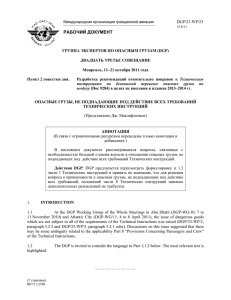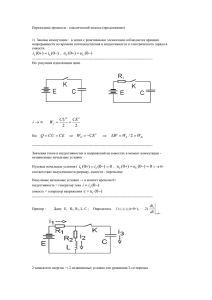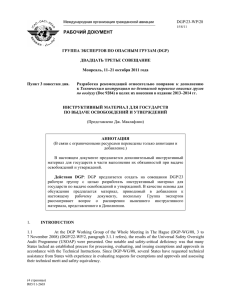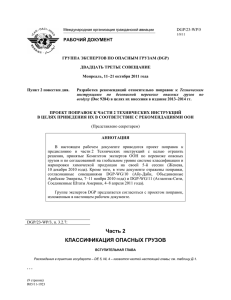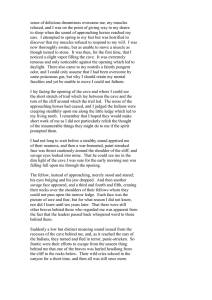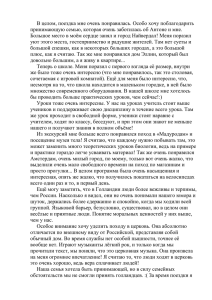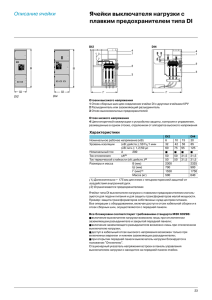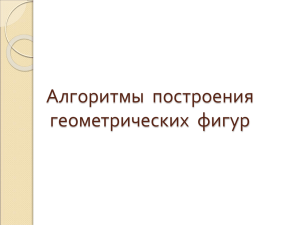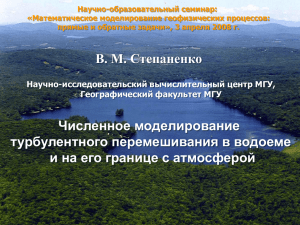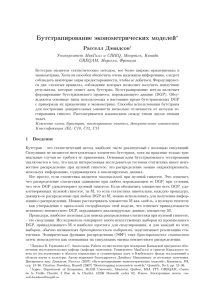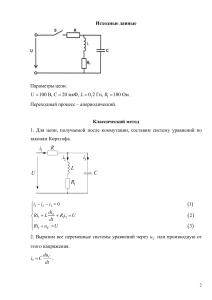ГРУППА ЭКСПЕРТОВ ПО ОПАСНЫМ ГРУЗАМ (DGP)
реклама
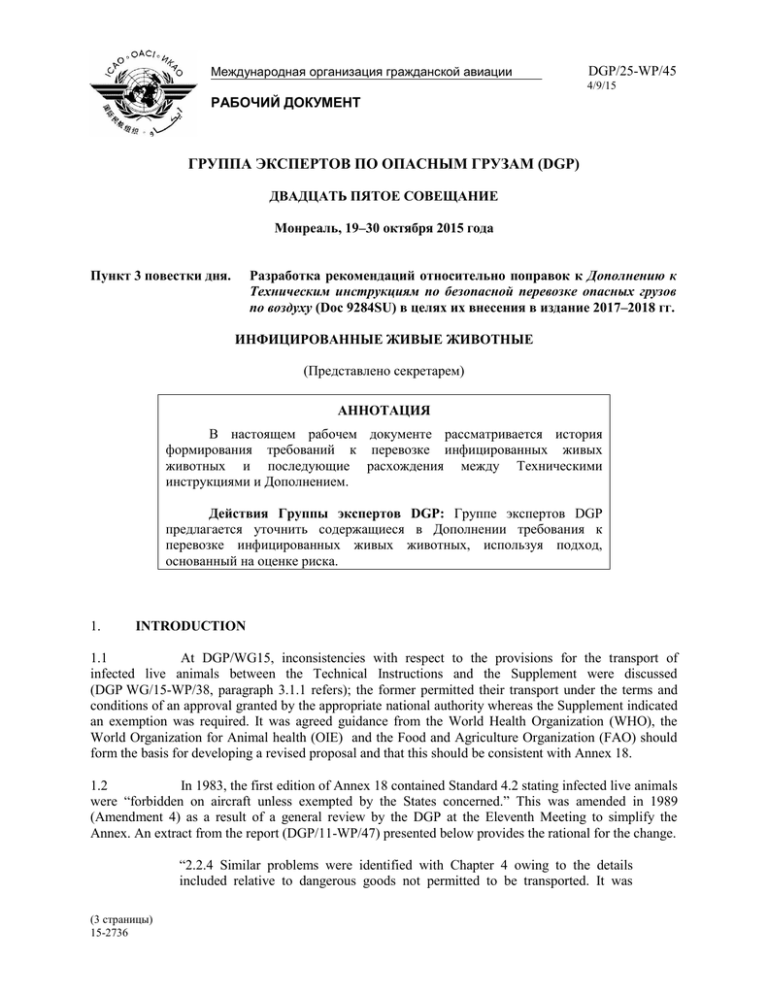
Международная организация гражданской авиации DGP/25-WP/45 4/9/15 РАБОЧИЙ ДОКУМЕНТ ГРУППА ЭКСПЕРТОВ ПО ОПАСНЫМ ГРУЗАМ (DGP) ДВАДЦАТЬ ПЯТОЕ СОВЕЩАНИЕ Монреаль, 19–30 октября 2015 года Пункт 3 повестки дня. Разработка рекомендаций относительно поправок к Дополнению к Техническим инструкциям по безопасной перевозке опасных грузов по воздуху (Doc 9284SU) в целях их внесения в издание 2017–2018 гг. ИНФИЦИРОВАННЫЕ ЖИВЫЕ ЖИВОТНЫЕ (Представлено секретарем) АННОТАЦИЯ В настоящем рабочем документе рассматривается история формирования требований к перевозке инфицированных живых животных и последующие расхождения между Техническими инструкциями и Дополнением. Действия Группы экспертов DGP: Группе экспертов DGP предлагается уточнить содержащиеся в Дополнении требования к перевозке инфицированных живых животных, используя подход, основанный на оценке риска. 1. INTRODUCTION 1.1 At DGP/WG15, inconsistencies with respect to the provisions for the transport of infected live animals between the Technical Instructions and the Supplement were discussed (DGP WG/15-WP/38, paragraph 3.1.1 refers); the former permitted their transport under the terms and conditions of an approval granted by the appropriate national authority whereas the Supplement indicated an exemption was required. It was agreed guidance from the World Health Organization (WHO), the World Organization for Animal health (OIE) and the Food and Agriculture Organization (FAO) should form the basis for developing a revised proposal and that this should be consistent with Annex 18. 1.2 In 1983, the first edition of Annex 18 contained Standard 4.2 stating infected live animals were “forbidden on aircraft unless exempted by the States concerned.” This was amended in 1989 (Amendment 4) as a result of a general review by the DGP at the Eleventh Meeting to simplify the Annex. An extract from the report (DGP/11-WP/47) presented below provides the rational for the change. “2.2.4 Similar problems were identified with Chapter 4 owing to the details included relative to dangerous goods not permitted to be transported. It was (3 страницы) 15-2736 DGP/25-WP/45 -2considered preferable that the chapter should now make general statements about limitations on the transport of dangerous goods and the detail would be in the Technical Instructions.” 1.3 Specifically, the Standard in 4.2 was modified so that infected live animals were “forbidden on aircraft unless exempted by the States concerned or unless the provisions of the Technical Instructions indicate they may be transported under an approval issued by the State of Origin.” However, the corresponding provision in the Technical Instructions was not changed until the 2005-2006 Edition. This edition incorporated changes from the 13th Revised Edition of the UN Recommendations on the Transport of Dangerous Goods and included major changes to the provisions for infectious substances including the move from the concept of using risk groups for transport classification purposes to that of different categories as well as the development of new packing instructions. In order to align with the UN, a new provision 2:6.3.2.6 was developed: “A live animal that has been intentionally infected and is known or suspected to contain an infectious substance must not be transported by air unless the infectious substance contained cannot be consigned by any other means. Infected animals may only be transported under terms and conditions approved by the appropriate national authority.” 1.4 The corresponding chapter in the Supplement, S-1;2, “Limitation of dangerous goods on aircraft — infected live animals” and dating from 1982 and which refers to exemptions, was not amended accordingly and thus the inconsistency has been created. 1.5 Based on the above explanation for the inconsistency, and noting that the WHO adopted a risk based approach when revising the classification criteria for infectious substances and that the OIE provides guidance on the transport of live animals, it is suggested the Supplement should be revised to take this into account and to clarify the requirements. Depending upon the outcome of the discussion, a consequential amendment may be required for 2;6.3.6.1 of the Technical Instructions. 2. ДЕЙСТВИЯ ГРУППЫ ЭКСПЕРТОВ DGP 2.1 Группе экспертов DGP предлагается внести поправки в главу 2 части 1 Дополнения в соответствии с добавлением к настоящему рабочему документу. ———————— DGP/25-WP/45 Appendix ДОБАВЛЕНИЕ ПРЕДЛАГАЕМАЯ ПОПРАВКА К ЧАСТИ S-1 ДОПОЛНЕНИЯ Часть S-1 ОБЩИЕ ПОЛОЖЕНИЯ ... Глава 2 ОГРАНИЧЕНИЕ ПРИ ПЕРЕВОЗКЕ ОПАСНЫХ ГРУЗОВ НА ВОЗДУШНЫХ СУДАХ: ИНФИЦИРОВАННЫЕ ЖИВЫЕ ЖИВОТНЫЕ 2.1 Вопрос использования животных для перевозки инфекционного вещества необходимо рассматривать лишь в тех случаях, когда данное вещество невозможно перевозить каким-либо другим образом. Инфицированных животных можно перевозить лишь при наличии освобождения заинтересованных государств в соответствии с положениями и условиями разрешения, выданного соответствующими полномочными органами государства отправления, [транзита], [назначения] и эксплуатанта. 2.2 Таких инфицированных животных необходимо перевозить в упаковочных комплектах, характеризующихся бактериологической стойкостью по крайней мере не меньшей, чем у комплектов, используемых при перевозке незараженных животных. Такие грузовые партии необходимо объявлять декларировать и снабжать знаками "Живое животное" и "Инфекционное вещество". 2.23 Если какую-либо пустую емкость необходимо вернуть грузоотправителю, перед отправкой ее следует тщательно продезинфицировать/стерилизовать. Кроме того, все знаки (знаки опасности "Живое животное" и "Инфекционное вещество") необходимо убирать, стирать или удалять другим образом (см. также главу 6 части S-6). Примечание 1. При рассмотрении запросов на получение такого разрешения необходимо применять подход, основанный на оценке риска, в зависимости от того, относится ли данное инфекционное вещество к категории A или B и от того, относится ли оно к ООН 2814 или ООН 2900. Если инфекционное вещество относится к ООН 2814, необходимо получить разрешение как органов общественного здравоохранения, так и полномочных ветеринарных органов. Примечание 2. Инструктивный материал по международным стандартам ввоза/вывоза живых животных представлен в Кодексе здоровья наземных животных (http://www.oie.int/en/international-standard-setting/terrestrialcode/access-online) и в Кодексе здоровья водных животных МЭБ (http://www.oie.int/en/international-standardsetting/aquatic-code/access-online). ... — КОНЕЦ —
